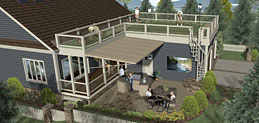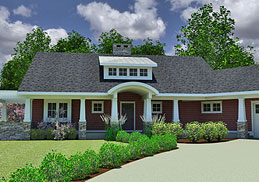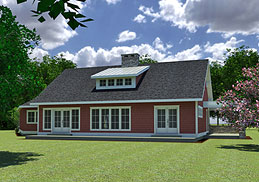Green Home Building Trends for 2012
With spring right around the corner, it's the perfect time to take a look at some of the green home building trends that will shape our decisions in the coming year. You'll find that many of these trends were inspired by pure economics, while others developed from great advancements in technology and home design. If you're in the market to build or renovate, you'll certainly find at least one of these trends that is appealing enough to consider.
Higher-performing homes are the new norm, featuring energy-efficiency, durability, low maintenance and curb appeal. This award-winning
ENERGY STAR house plan leads the way in new and innovative green home design by maximizing all available space and utilizing the latest in home building technology like wind generators and a grass roof tile system.
Most consumers will be building a home with a smaller footprint (according to the NAHB new homes will average 2,150 sq. ft. by 2015), which means a lower cost for materials and labor, as well as less energy to heat and cool finished spaces. A smaller home doesn't have to mean less space or less functionality if you choose a well-designed house plan with an open floor plan and flexible spaces.
Also on the rise are home renovations, which is actually a very green initiative because it saves on building materials and waste and preserves underdeveloped land. If you are renovating, be sure to invest in energy-efficient upgrades that will reduce your home's heating and cooling loads by adding more insulation in the walls, roof and floors, sealing leaks, replacing windows and upgrading old HVAC equipment, appliances and lighting with ENERGY STAR® rated models.
This green one-story Craftsman Cottage House Plan makes great use of its 1,864 sq. ft. A center masonry fireplace and plenty of ENERGY STAR® windows warm the open kitchen, living room and dining room.
For the extreme green homebuilders, there's the option to make your home net-zero. A net-zero home generates as much energy as it consumes, thus netting out zero energy. Most net-zero homes achieve this by combining a variety of passive (carefully placed windows, natural ventilation and insulated wall) and active design strategies, like solar systems, wind turbines and geothermal wells.
Another new term for 2012 will be net-zero water, which will focus on low-flow showerheads, faucet aerators and recycling water through rainwater collection systems and greywater reuse to help preserve this depleting natural resource. Updating plumbing fixtures is easy and makes perfect sense to homeowners, as does rainwater collection systems however the jury is still out on recycling water. Basically you are recycling greywater, which comes from places like your washing machine, bathroom sink, shower and bathtub. While it's much cleaner than blackwater (comes from toilets, dishwashers and garbage disposals), it can't be consumed.
Thanks to smart technology, it is now easier than ever for homeowners to monitor their home energy use in real time from smartphones and laptops. New energy monitoring systems tie into your home's circuit so you are aware of your energy consumption 24/7. Popular models include The Energy Detective (TED)®, GE® Nucleus, and the eMonitor® by Powerhouse Dynamics®. As more models become available this year, you can expect the cost to drop.
Design Tip
If you're truly committed to building a green home, then you'll want to start with an ENERGY STAR/Green House Plan Package from The House Designers. With this package you will receive detailed drawings, wall and roof insulation, glazing specifications and information on cooling calculations for your specific area plus information on getting your home built and certified to ENERGY STAR® standards.



.png)
.png)





